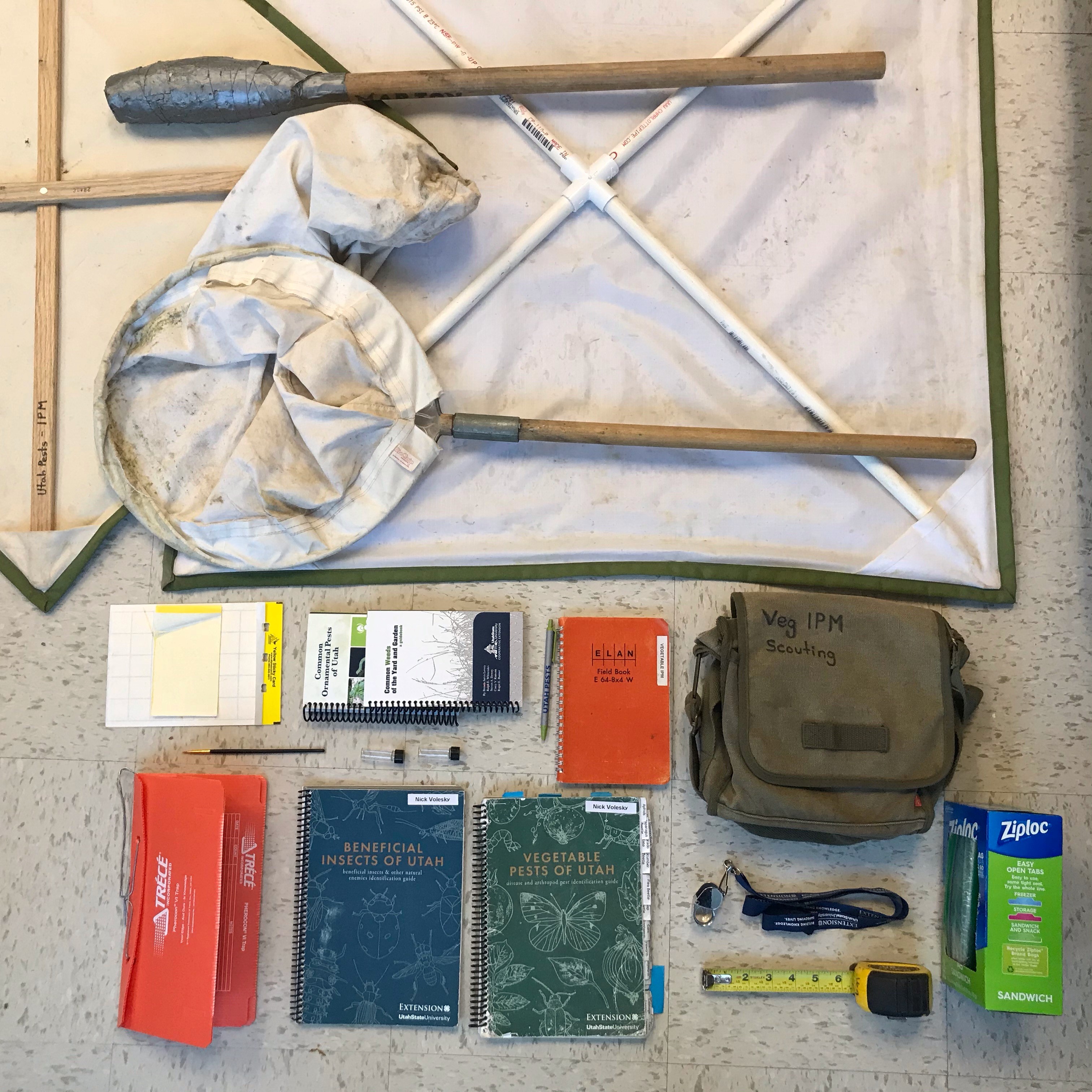How to Monitor
 Visual inspections may be conducted by examining the plant with a hand lens (at least 20x in magnification), using a sweep net, or by using a “beat cloth” for taller plants. A sweep net is helpful to count insects that are mobile, such as stink bugs or leafhoppers. A beat cloth is a white or light-colored cloth attached to dowels or fitted into a frame, and is placed underneath a vigorously shaken plant to catch insects. Sweep nets and beat cloths will allow you to quickly cover more ground.
Visual inspections may be conducted by examining the plant with a hand lens (at least 20x in magnification), using a sweep net, or by using a “beat cloth” for taller plants. A sweep net is helpful to count insects that are mobile, such as stink bugs or leafhoppers. A beat cloth is a white or light-colored cloth attached to dowels or fitted into a frame, and is placed underneath a vigorously shaken plant to catch insects. Sweep nets and beat cloths will allow you to quickly cover more ground.
For each plant to be inspected, examine all plant parts (leaves, stems, and vegetables). Look for plant injury as well as signs of insects or disease, and record the following:
- Symptoms such as chewed areas, spots or discolorations, wilting, cavities/sunken areas, rot, or reduced growth.
- The number of pest insects per plant, or percentage of plant affected by insect feeding or disease.
- The number of beneficial insects you may encounter.
- Soil moisture conditions (wet or dry) and competition with weeds
Monitoring with Traps
Insects communicate using chemical substances they produce called pheromones. Pheromones of some vegetable pests have been synthesized and are available to purchase as a “lure” for use in monitoring traps. Pheromone traps are primarily used for moth species including corn earworm, cutworms, armyworms, diamondback moth, cabbage looper, and others.
- “Delta” traps include a triangular, plastic housing with a removable sticky liner. The specific moth’s pheromone is imbedded in a separately packaged rubber septum that is placed on the center of the sticky liner.
- “Heliothis” traps are used for corn earworm, and include a fabric and mesh cylinder inside which the lure is hung.
- Traps are hung on small posts above the crop in spring, and spaced at least 20 yards apart.
- Check traps every week and record the counts. The pheromone traps will provide an indication of the timing of adult activity and abundance of the species.
Essentials of Pheromone Lures and Traps
Traps are sold as “large plastic delta” or “wing-style.” We recommend the delta traps for ease of use (sticky liners easily slide in and out) and durability (reusable for 5 years or more). Do not use white-colored traps, as these attract bees.
Lures run about $1.20 each. Wing-style traps are approximately $2 each and only last one season. Delta traps are approximately $5 each. All traps should be labeled with name of the insect lure used and should not be used it for another insect. Store unopened lures in the freezer (up to 2 years) until use or they will lose effectiveness.
Pest Monitoring Toolkit
- 10-30x hand lens
- Orange delta traps for certain moth pests and/or Heliothis trap for corn earworm
- Extra sticky liners for traps
- Beat cloth
- Sweep net
- Vials of alcohol, tweezers, a small paintbrush, and plastic containers for collecting unknown specimens
Field Guides
- Garden Insects of North America (Whitney Cranshaw and David Shetlar)
- Vegetable Pests of Utah: Disease and Arthropod Pest Identification Guide (Utah State University Extension)
- Beneficial Insects of Utah Identification Guide (Utah State University Extension)
- Utah Vegetable Production and Pest Management Guide (Utah State University Extension)
- Pests of the Garden and Small Farm (University of California Extension IPM)
- Vegetable Pest Identification for Gardens and Small Farms (University of California Extension IPM)
Sources of Monitoring Supplies
Great Lakes IPM
Vestaburg, MI
800-235-0285
greatlakesipm.com
Trécé
Salinas, CA
408-758-0205
trece.com
Gemplers
Mt. Horeb, WI
800-382-8473
gemplers.com
Alpha Scents
West Linn, OR
503-342-8611
alphascents.com

